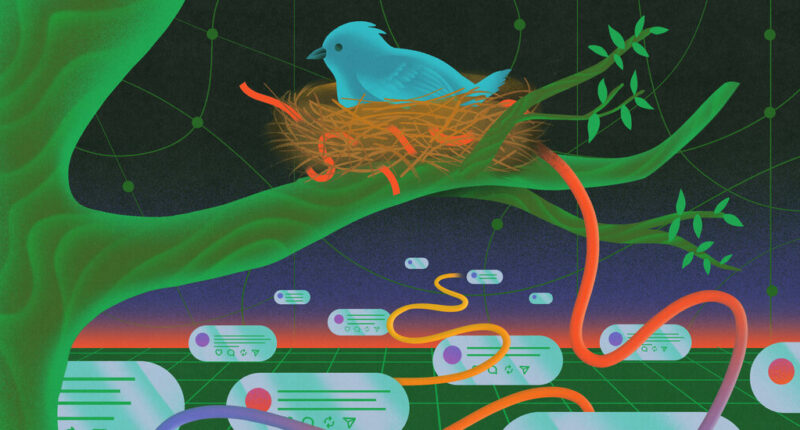
When we — Brian X. Chen and Mike Isaac, both longtime tech journalists — got an assignment from our editor last week to review Threads, the new social network from Meta, it was like a blast from the past.
Both of us have written about social networks for over a dozen years. In the last half dozen of those years, the social media landscape has been largely static — with the exception of the rise of the short-video app TikTok — and was dominated by Meta, which owns Instagram and Facebook.
The arrival of Threads, which was spun out of Instagram and is aimed as a prime place for public, real-time conversations, shakes up that scene. While the new app could end up a fad, it could also be a potent threat to Twitter, which has retained its crown as a hub of conversation for more than a decade.
But how many of us will hang out on Threads? We wondered how we would take to it since one of us — Brian — is a casual Twitter user, and the other — Mike — is a longtime Twitter addict, which might affect our experience with Meta’s new app. Here’s what we found about Threads’ pros and cons and whether it might become a part of your life.
BRIAN Hello, Mike! It’s been a while since we did a collaborative review. Years ago we nerded out on the new PlayStation and Xbox releases. And now we’re back together — why, again?
MIKE Yes, we’re back, this time to peruse the hottest social app of the moment, Threads, which is made by Meta. After playing with it for a few days, I’m starting to wonder if I can kick my Twitter addiction by replacing it with a “friendlier” social network crafted by Mark Zuckerberg, Meta’s chief.
So far, I’m enjoying it. But it definitely feels like a stripped-down version of Twitter. No hashtags, heavy on the influencers — and the worst part is, a lot of the people in my replies don’t seem to get my jokes that usually do well on Twitter.
Brian, I’m worried that all the people coming to Threads from Instagram just don’t know how to post.
BRIAN Well, that’s the interesting thing. Threads is a Twitter clone, but Meta is introducing the concept to never-tweeters who have been on Instagram. So there’s going to be an awkward phase of acclimating.
But let me back up for a second. Threads is a free app you download from the Apple or Google app store. To set it up, you connect it with your Instagram account. Threads then invites you to follow all your friends on Instagram.
From there, it shows a timeline of posts, and you can compose short memos that get published for the public to see. You can embed photos, too, but the focus is text, just like on Twitter.
What are the differences from Twitter that you immediately noticed?
MIKE It feels like Twitter, but on easy mode.
For one, Threads is algorithmically curated, just like Facebook or Instagram. That means when you come in, you see a bunch of different posts based on your interests, whether they were posted five hours ago or five minutes ago. (Is it posted, or is it threaded? Have we decided on the verbiage yet?)
That’s a departure from what we’re used to with Twitter, where the marquee feature is the reverse chronological timeline. That means you see every single post from people you follow in reverse order, which made Twitter indispensable for breaking news and live events.
With Threads, I think the algorithmic curation is intentional on Instagram’s part. They have said they want to make Threads “friendly” as people enter. It feels a bit sterile to me, but I’m also not being bombarded with hate speech and racist tirades, which I consider a big plus.
BRIAN To me, Meta’s interest-based algorithm is a major turnoff. It’s made my Threads feed a pile of posts from accounts I don’t follow, primarily influencers and brands advertising their products. I see very few posts from my actual friends.
To be fair, Twitter’s timeline isn’t great, either. The quality is deteriorating because of changes that affect what people read on the site, including the requirement to pay $8 a month for a Twitter Blue subscription for your posts to show up on others’ timelines.
One other big difference between Threads and Twitter: The character limit on Threads is 400 characters, whereas on Twitter it’s 280 characters for free accounts.
Are more characters a good thing?
MIKE I don’t think so. Brevity is the soul of wit, right? A banger of a tweet comes in short form, in my opinion, not writing a blog post inside of what’s supposed to be a brief message.
Twitter has tested this paid Twitter Blue option where people can post insanely long tweets of 10,000 characters. I feel like that’s getting away from the original point of Twitter’s short-form messages. But maybe I’m just a curmudgeon.
I’m curious: How has it been for you on Threads, overlapping your Twitter-self with your Instagram following?
It’s been a schizophrenic experience for me. I’m very different on my Insta than on Twitter. On Insta, I’m usually posting things I’ve cooked that week or the latest concert I’ve attended. Twitter is more my space for writing about work and the tech industry, while occasionally posting snippets from my personal life. Threads feels like a hybrid of both — at least for the moment.
BRIAN It’s been tricky for me, too, so I haven’t posted much. Like many people, I converted my Instagram into a private account years ago because I didn’t want the public to see photos of my family. It became a “friends-only” network.
With Threads, I now have to think again about what I would share publicly. It’s a trip.
MIKE Totally hear you. I’m still going to try it, but I’m curious if you think this is going to be the next big thing? Especially given that you’re somewhat less active on Twitter than I am.
BRIAN I don’t place bets on tech products as if they are horses. But based on my reporting about how everyday people — who use tech but don’t obsess over it — engage with social networks, they probably won’t post much on Threads.
The truth is Twitter isn’t a social network, and neither is Threads. Both are broadcasting platforms for big brands, celebrities, politicians and media outlets to share information with their followers.
This type of network isn’t conducive to how people actually socialize in communities. In social clubs, people congregate in smaller groups around shared interests. They don’t crowd into an enormous conference room and shout like we do on Twitter and now Threads.
MIKE Absolutely. I have a decent Twitter following that mostly knows what it’s going to get from me and understands when I’m joking. But I’m very aware that when a tweet of mine goes viral and travels outside that sphere of people who know me, I am 100 percent going to get misinterpreted — and probably insulted. We call that “context collapse.”
BRIAN Meta knows this, too. You reported a few years ago that Mark Zuckerberg said people were increasingly shifting away from the big social media platform toward smaller, more siloed networks. Those included private Facebook groups and messaging apps.
MIKE Shout out to the private Slack and Discord groups I’m in that only contain a handful of close friends.
BRIAN And that all makes sense. People have learned that it’s not a great idea to share lots of personal information in the public sphere.
Also, if I want to talk to you, why would I @ you publicly rather than message you? That’s probably the biggest thing Threads lacks compared with Twitter — direct messaging — which makes Threads an inferior product at the moment. But it’s a matter of time until that’s added, since that feature is already part of Instagram.
MIKE I do think there’s a sort of performative element to talking in the public sphere, where my conversations with you take on a different tone and meaning — sort of like we’re talking onstage in front of an audience. There’s something fun about that. But it often can get very unfun very quickly. Messaging, as you note, helps circumvent that.
BRIAN For engaging with brands and influencers, text has also already lost the battle. The growing popularity of TikTok and Instagram’s Reels is evidence that casual tech users, especially young people, would rather see videos of the celebrities and influencers they follow and not read their bite-size text.
At the end of the day, comparing Twitter and Threads is tough since Threads is part of Instagram, which is much larger than Twitter. If the features improve, I could see myself switching to Threads from Twitter eventually because of Instagram’s sheer size, which could bring me more followers. (I’m @bxchen on Threads, by the way.) But like others, I probably won’t spend much time hanging out with friends there.
What about you?
MIKE Right now I’m doing the inconvenient juggling act of trying to post different things to six different networks, and it is not exactly fun. But I assume at least something will die off eventually and I can stop churning out the posts. At least, I hope so.
See you on … Threads, I guess?
BRIAN You need to follow me back first, Mike.
Source: | This article originally belongs to Nytimes.com








